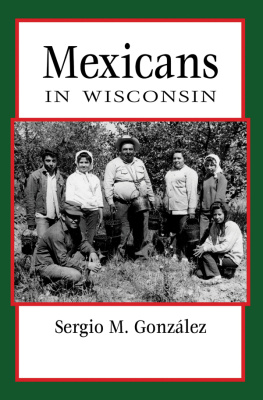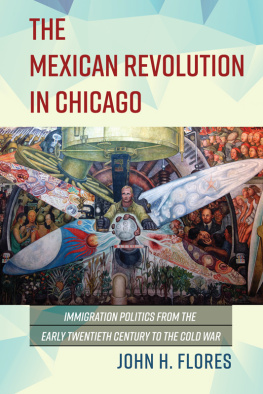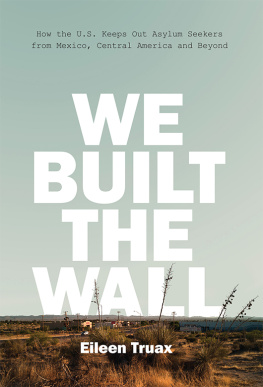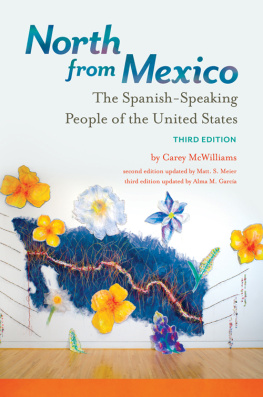Table of Contents
Pagebreaks of the print version
Guide

To my son, Guillermo, for his endless light.
INTRODUCTION

THIRTY YEARS OF RESISTANCE
THE IDEA FOR THIS BOOK emerged a few days after Donald Trumps presidential victory in November 2016. Because of my experience writing about immigrant communities, people started asking me how Mexicans in the US would defend themselves now that he was president and after he had attacked them so viciously. And every time I attempted to reply, I came up with the same answer: the defense has already been mounted; it will just be put into action once again. What I meant is that the immigrant communities that came under attack during Trumps campaignand presidencyhave been targeted and beaten down for decades and via a succession of presidents, both Republican and Democrat. And, like all minorities in this countryreligious, racial, and ethnicin order to triumph, Mexicans in the United States have first had to resist.
This book recounts the stories of men and women who left Mexico ten, twenty, or thirty years ago in search of a better life in the United States. They have faced violations of their rights and their dignity and have suffered all manner of violence. Like millions, these Mexican men and women have worked diligently over the course of three decades to create networks of resistance and solidarity and keep forging ahead. They have refused to be the victims of the broken systems of both countries and have triumphed over adversity against all expectations. Thanks to this history of struggle and perseverance, on both sides of the border, they are standing up to the politicians in the United States who convey, in words and in actions, that they are not wanted here.
For those of us who have lived in the US for decades, racism, xenophobia, and classism are mainstays of the social fabric, just like many other aspects of a nations complex identity. I have lived in this country for fourteen years, working as a journalist all the while, immersed in the issue of immigration. I have written two other books and dozens of articles, and Ive read hundreds more on this subject. But for many people, the prejudice and xenophobia only became noticeable when Donald Trump arrived on the scene, as his rise often became the shorthand explanation for the ills of society. One day after the election, denunciations of racist and anti-immigrant attacks began to appear from across the country, which, thanks to the magic of share and retweet buttons, pointed to a seeming escalation of hate crimes. But escalation as compared to what, if most people dont know what the previous figures were that might prove an increase?
Certainly, Trumps campaign rhetoric and the insults and threats he has hurled once in office have meant that those who hold racist and anti-immigrant views now feel validated, with a greater right to openly question, attack, and incite violence against minorities. Events such as the clash in Charlottesville, Virginia, in August 2017, when a rally of white supremacists ended in the death of one counterprotester and injuries to several others, have fueled this perception. But the history of racism and xenophobia in the United States goes back centuries, and it has survived, and in some instances even sharpened, in recent decades. White supremacist ideologies and proposals to limit the exercise of civil rights are a latent virus that boldly resurfaces under certain circumstances. Personalities such as Donald Trump should not be viewed as a cause but as a consequence. The atmosphere in the United States in recent years is a symptom of a social dynamic that follows the pendulum theory: for every advance by progressive groups, theres a simultaneous reaction in the opposite direction.
In August 2014, the Southern Poverty Law Center published its report on hate groups in the United States; there were 939. Thats almost a thousand hate groups, including neo-Nazis, the KKK, skinhead racists, white nationalists, anti-LGBT groups, anti-Muslim groups, black separatists, border vigilantes, and other anti-immigrant groups. Of those, half were located in the South. In the four states bordering Mexico aloneCalifornia, Arizona, New Mexico, and Texasthere are 160 active hate groups. There has been a pronounced uptick especially in California and Arizona, where the predominant groups are anti-immigrant and anti-Latino.
Between 2000 and 2013, the number of hate groups in the United States grew by 56 percent. This period coincided with a reinforcement of border security in the wake of the terrorist attacks of September 11, 2001; an increase in the proportion of nonwhite immigrants; the financial recession of 20089; and the election of Barack Obama, the first African American president. All of these factors contributed to the growth of hate groups. And, yes, many of these elements were opportunistically exploited in Trumps campaign rhetoric. People who sympathized with the views of those groups found a spokesman who validated their outrage, but they were already in place before Trump came along. In a 2012 report, the FBI registered more than 5,000 hate crimes, involving over 7,000 victims. The number increased to 5,800 in 2015 and 6,100 in 2016. In those three years, more than half were targeted because of bias against the victims race or ethnicity.
With the prevalence of mobile devices and social media, these incidents can be easily and widely disseminated, and that in turn has opened the door to higher rates of prosecution and conviction for these crimes. The publics perception may be that the number and frequency of these incidents is rising, but data from past years would have to be carefully reviewed for comparison to confirm that.
The data plainly shows that racial violence and discrimination are a mundane daily reality among certain communities in the United States, particularly for Mexicans and Mexican Americans. All of us who were born outside the US or are the children of immigrants have heard at one time or another Go back to your country!the first time for me was outside a supermarket in 2005. And we have all been the victims of or have witnessed some type of racial violence that has made us feel fearful and profoundly unwanted in this country we call home. None of this is Trumps fault: the incendiary rhetoric spewing from the White House is not the cause of this countrys problemsor those of our neighbor to the southbut the result.
, for example, includes the story of Claudia Amaro, from Kansas, who inspired the title for this book. I have known Claudia for five years and have closely followed her and her familys continuing story. In one of our most recent conversations, Claudia told me that once when she was feeling particularly hopeless she had asked a white woman, Why doesnt the US want us? In my experience, this is the question that immigrants puzzle over, the question that gets under their skin, especially when they are the victims of workplace abuse or bigoted comments, when their children are victims of bullying at school, or when a politician in power insults and stigmatizes an entire community in spite of their struggle and hard work every day.
The thirteen stories presented in this book reflect the stories of the millions of Mexicans in the United States. Most of the protagonists in these pages arrived in this country undocumented; some have managed to attain legal status, while others are still fighting for it. Three of them came to the United States with legal documents but had to overcome obstacles stemming from language barriers or their country of origin, skin color, or sexual orientation. Some stories have to do with work done by the Mexican community in the US to defend civil and human rights: the right to health care, education, work with dignity, access to information, family reunification, political representationand the right to live peacefully in the land where one works and, in spite of everything, the land one loves.










